
Have you ever thought about what a chicken's face would look like without that characteristic beak? Well, scientists recently embarked on this peculiar journey, promoting facial transformations in human embryos. chicken that resulted in something unusual: snouts similar to those of dinosaurs, instead of the traditional beaks of birds.

see more
What happens if you use vinegar to water your plants?
This simple potato trick is making the plants incredibly…
Photo: Bhart-Anjan Bhullar / Disclosure.
The study, which gained prominence in the renowned Nature magazine, is not a fancy attempt to bring dinosaurs back to life, but rather a curious strategy to unravel the mysteries of evolution that transformed the imposing reptiles of the past into our familiar chickens yard.
In a simplified dive into this evolutionary trajectory, it is clear that the transition from dinosaurs to birds was a challenging process. There was no specific anatomical feature that distinguished the precursor birds from their carnivorous relatives, the dinosaurs.
The initial stages of this evolution reveal that the bones that formed the snout of reptiles, the so-called premaxilla, went through a process of growth and fusion to give rise to what we know as nozzle. The paleontologist Bhart-Anjan Bhullar, from the University of Chicago, highlights that live birds provide valuable clues about the lives of dinosaurs, with the transition from snout to beak being one of the most significant changes in the skeleton aviary.

Photo: Bing Image Creator.
Before delving deeper into the lives of these winged dinosaurs, researchers went on a journey to understand what, in fact, characterizes a beak. By analyzing the embryonic development of the beak in chickens and emus, in addition to the snout in crocodiles, lizards and turtles, they identified two proteins, FGF and Wnt, that guide facial development in these species.
By constraining these proteins at key points of facial development in chicken embryos, scientists observed striking differences in the laboratory. The chickens resulting from these experiments had flaps of skin in place of beaks, as well as shorter, more rounded bones in contrast to the long, fused beaks of traditional birds.

Photo: Bing Image Creator.
This research, in addition to being provocative, launches ethical reflections on the extent to which we can rewind the biological clock of birds to uncover the secrets of their ancestors. Just imagine, exploring the past to understand how chickens became, in a way, the modern dinosaurs of our backyards.
So, who would have thought that our feathered friends would have something so intriguing tucked away under their beaks? The mystery continues to be unraveled by scientists, who explore the unknown terrain between dinosaurs and chickens.


